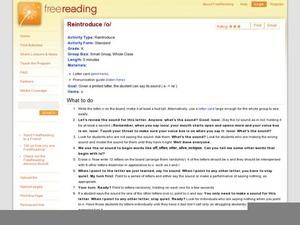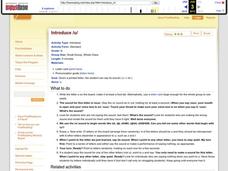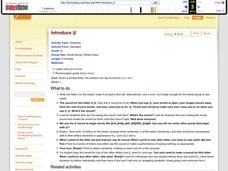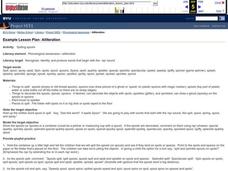Curated OER
Reintroduce /O/
Students study letters. In this letter identification lesson, students practice recognizing and making the sound for the letter "o." They work as a class to actively participate in various drills the teacher takes them through. This...
Curated OER
Introduce /U/
Students study letters. In this letter identification lesson plan, students practice recognizing the letter "u" and pronouncing the sound it makes. They participate in various group activities practicing the use of the letter "u." This...
Curated OER
Introduce /J/
Students determine how to write and say the sound of /j/. In this letter identification lesson, students practice making the /j/ sound and write the letter after seeing it modeled. They locate the letter /j/ among others when they are...
Curated OER
Reintroduce /Z/
Students are reintroduced to the letter "Z" and review its sound. In this letter "Z" instructional activity, students review words that begin with the letter "Z" then think of other words that begin with the letter "Z" while they...
Curated OER
Introduce /S/
Students determine when the letter s has been pointed out by the teacher and say its sound. In this phonics lesson, students learn the "s" sound and practice saying words beginning with the letter.
Curated OER
Introduce /Y/
Pupils are introduced to the letter "y" and practice its letter sound. In this letter "y" lesson, students review words that begin with the letter sound "y" and take turns reciting the sound of the letter "y."
Curated OER
Introduce /V/
Students are introduced to the letter "V" and its sound. In this letter "V" instructional activity, students practice saying the sound made by the letter "V" and touch their throats to make sure their voice boxes are on track. Students...
Curated OER
Chauncey Chicken and Consonant Digraphs
In this consonant digraphs worksheet, 2nd graders complete the words inside the egg by adding the consonant digraph ch or sh to either the beginning or ending section of each word.
Curated OER
Practicing Letters m and n
Pair printing practice with initial sound recognition using a matching worksheet. Learners focus on lowercase letters m and n as they match each to words that begin with the same sound. There is space for printing...
Curated OER
Alphabet Worksheet: Letter W Recognition
This worksheet includes 19 problems that require identifying words or pictures that begin with the letter 'W'. The pictures that begin with the letter 'W' are to be colored.w
Curated OER
Double Jeopardy-Homophones
Second graders identify homophones as words that sound alike but have different meanings. They, given a pair of homophones, are to explain the meanings of the words using gestures, role playing, or drawing a picture with their partner.
Curated OER
Alliteration
Students recognize, identify and produce words that begin with the /sp/ sound. They decorate objects that have the /sp/ sound with items that have the /sp/ sound. Students create phrases with the /sp/ sound that describe the object...
Curated OER
Alphabet Worksheet: Letter M Recognition
Letter learners identify words that begin with the letter 'M' and then color the images that begin with the letter 'M'. There are 20 problems in total.
Curated OER
Language Acquisition
Detailing the stages of language, sound, word, and grammar acquisition for babies, this presentation is a great addition to a lecture that focuses on how the English language is developed in small children. Additionally, the slideshow...
Curated OER
Alphabet Worksheet: Letter Z Recognition
Alphabet learners identify words that begin with the letter 'Z' and then color in the pictures that start with the letter 'Z'. There are 19 problems in total.
Indiana University
World Literature: "One Evening in the Rainy Season" Shi Zhecun
Did you know that modern Chinese literature “grew from the psychoanalytical theory of Sigmund Freud”? Designed for a world literature class, seniors are introduced to “One Evening in the Rainy Season,” Shi Zhecun’s stream of...
BBC
The Patchworker - Sentences Making Sense
An entertaining and educationally sound lesson on sentence structure is here for you. Young readers play an online game called "The Patchwork Game" where they must patch together a series of words in order to create a complete sentence....
Curated OER
Nouns in a Story
Students, assessing a variety of formatting tools with Microsoft Word, utilize a bank of vocabulary words to make a personal dictionary of nouns. They classify nouns for people, places, things and ideas and separate them into common and...
Curated OER
Dr. Seuss’s ABC: An Amazing Alphabet Book Lesson
Dr. Seuss's ABC Book is used to help young readers distinguish between the letters of the alphabet and their letter sounds. After a discussion reviewing the letters that are vowels and consonants, the book is read to the class. Then, the...
Curated OER
Bounce into Speedy Reading: Growing Fluency and Independence
Increased reading comprehension begins with decoding and automatically recognizing words, which is the focus of this instruction. Using their choice of six different Winnie the Pooh stories, partners practice a variety of strategies...
Scholastic
Leads in Narrative Writing
The beginning, a very good place to start, is also a very difficult thing to craft. Provide your writers with this handout that identifies, and provides examples of, six different types of narrative leads.
Curated OER
Describing Paintings: Calm or Stormy
Young writers use nouns, verbs, and adjectives to describe details in two paintings. One depicts a sunny landscape, and the other shows a cloudier view. They write a narrative inspired by the paintings, paying attention to transitional...
Curated OER
Odd One Out
One of these words doesn't belong! As they practice first-letter recognition, scholars examine rows of familiar objects to determine what letter each begins with. For each row of three items, they decide which does not begin with the...
Poetry4kids
How to Write a Repetition Poem
A repetition poem is the focus of a lesson that challenges scholars to compose an original piece. To add meaning to their poem, authors choose words to repeat at the start of most lines.

























